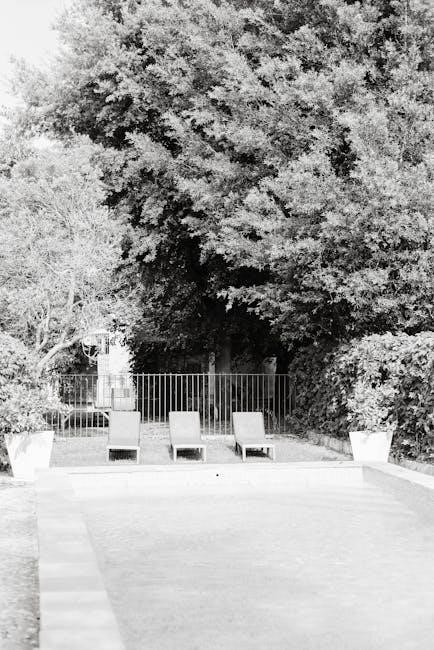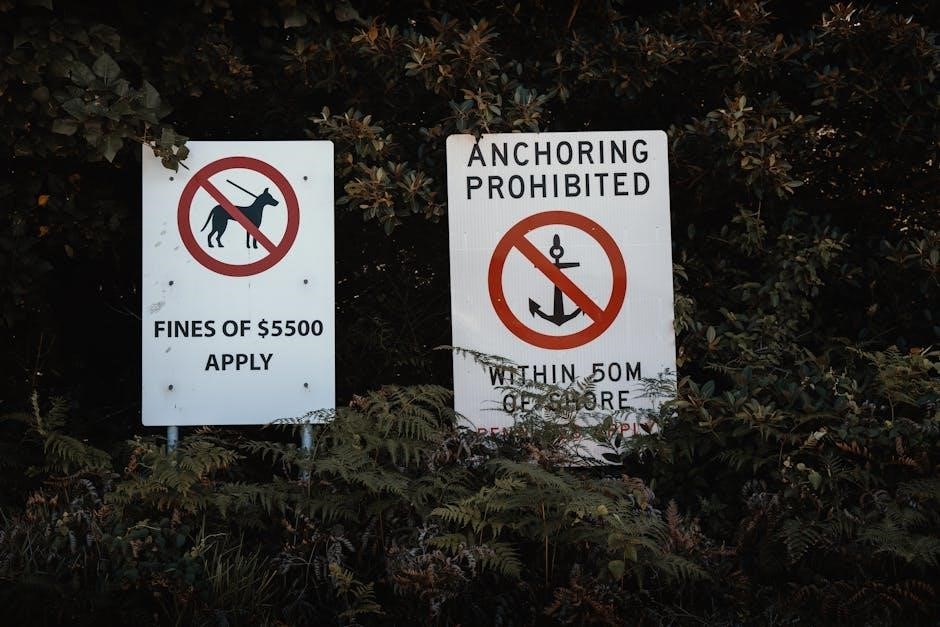NSW Pool Fencing Regulations Overview
Pool fencing in NSW is vital for safety, preventing drownings, especially for young children. Specific laws regulate pool fencing to ensure pool areas are safe and compliant with standards.

Key Legislation: Swimming Pools Act 1992 and Regulation 2018
The cornerstone of pool safety in NSW is the Swimming Pools Act 1992 and its accompanying Regulation 2018. This legislation applies to all swimming pools associated with residential buildings, movable dwellings, hotels, and motels. These laws work in tandem with Australian Standard 1926 (AS1926) to establish stringent safety benchmarks for pool barriers.
As a pool owner, responsibility lies in ensuring the pool is enclosed, restricting access to children at all times. Owners must ensure compliance with the relevant Australian Standards and Laws. New pool safety compliance laws introduced by the NSW government reinforce this commitment to safety. The legislation aims to continuously update pool barriers to current standards over time, triggered by specific events. The Act and Regulation outline the specific requirements for pool fencing, including height, materials, and gate mechanisms, to prevent unsupervised access to the pool area and minimize drowning risks.
Compliance Standards: AS1926.1-2012
Compliance with NSW pool fencing regulations in 2024 primarily involves assessment under AS1926.1-2012. This Australian Standard sets out the safety requirements for swimming pool safety, specifically related to safety barriers. Adhering to AS1926.1-2012 ensures that pool fences effectively restrict access to the pool area, particularly for young children, preventing potential drowning incidents.
Building or renovating a pool mandates compliance with specific pool fence requirements outlined in the Australian Standards. While installing a fence is necessary, it’s not sufficient for compliance. Assessments cover various aspects like fence height, non-climbable zones, and gate latch mechanisms. These standards exist to prevent unsupervised access to the water, and all pool enclosures must meet NSW’s swimming pool compliance regulations. Pool owners should familiarize themselves with AS1926.1-2012 to guarantee their pool fences meet the necessary safety criteria.

Pool Registration: NSW Swimming Pool Register
In NSW, QLD, and NT, a central swimming pool register exists. WA councils manage their own registers, overseeing inspections. The ACT and Victoria are considering similar registers. Pool owners must ensure barrier compliance before selling or leasing, but regulatory approaches vary.
Registration is essential. Check the NSW Swimming Pool Register at www.swimmingpoolregister.nsw.gov.au by entering your address. If unregistered, follow instructions to register your pool or spa. When buying, most prefer a compliant pool for easier borrowing and peace of mind. New owners often need help with rectification, so accredited certifiers can provide assistance tailored to the pool enclosure.
Registering helps authorities monitor pool safety and ensures compliance. It is a crucial step in maintaining a safe swimming environment and avoiding potential penalties. Always verify registration status before selling, leasing, or purchasing a property with a pool.

Certificate of Compliance: Validity and Requirements
A Certificate of Compliance confirms a pool meets safety regulations. It is valid for 3 years. It is required when selling or leasing a property with a pool in NSW.
Validity Period: 3 Years
In NSW, a Certificate of Compliance for a swimming pool is valid for a period of three years from the date of issue. This validity period is crucial for pool owners to understand, as it dictates how frequently they need to have their pool inspected to ensure ongoing compliance with the current safety regulations.
The three-year validity period is designed to strike a balance between ensuring pool safety and minimizing the burden on pool owners. Regular inspections are necessary to identify any potential issues that may arise over time due to wear and tear, environmental factors, or modifications to the pool area.
After three years, a new inspection is required to obtain a renewed Certificate of Compliance. This process helps to maintain a high level of safety around swimming pools and reduce the risk of drowning incidents, particularly among young children. Pool owners are responsible for keeping track of their certificate’s expiration date.
Requirement for Selling or Leasing
In NSW, when selling or leasing a property with a swimming pool, obtaining a valid Certificate of Compliance is generally mandatory. This requirement ensures that the pool meets current safety standards, protecting potential buyers or tenants from the risks associated with non-compliant pool fencing.
Property owners must ensure their pool barrier complies with the relevant Australian Standards and NSW laws before entering into a sale or lease agreement. This includes registering the pool on the NSW Swimming Pool Register and arranging an inspection by an accredited certifier.
Failing to obtain a Certificate of Compliance can lead to legal repercussions and potential liability in case of an accident. While selling with a non-compliance certificate is possible under certain conditions, it places the onus on the buyer to rectify any issues within a specified timeframe.
Non-Compliance Certificate: Selling with Non-Compliant Pool
In NSW, selling a property with a non-compliant pool is permissible under specific conditions. A Non-Compliance Certificate is issued, requiring the buyer to rectify issues within 90 days, ensuring safety.
Conditions for Sale with Non-Compliance
Selling a property with a non-compliant pool in NSW is permitted, but stringent conditions apply to protect public safety. A Non-Compliance Certificate allows homeowners to market and sell without immediate rectification, provided the pool doesn’t pose significant risk. Buyers must agree to rectify all non-compliance issues within 90 days. This option suits pools needing minor adjustments, not those presenting major hazards like neglected fencing or lacking separation from residences, streets, or neighboring properties.
Sellers must disclose the non-compliance to potential buyers, ensuring transparency. The certificate transfers the responsibility for compliance to the new owner. Inspections by accredited certifiers are crucial to determine the extent of non-compliance and necessary rectifications. Failing to meet the 90-day timeframe can lead to penalties and legal repercussions. Purchasers should seek expert advice to fully understand rectification requirements and associated costs before finalizing the sale. This process ensures both parties are aware of their obligations, prioritizing safety and adherence to NSW pool fencing regulations.
Rectification Timeframe: 90 Days
In NSW, when a property with a non-compliant swimming pool is sold, the new owner is granted a 90-day timeframe to rectify all identified non-compliance issues. This deadline is legally binding, and failure to comply within this period can result in significant penalties and legal repercussions. The 90-day window begins from the date of property settlement, emphasizing the urgency for the new owner to address the pool’s safety deficiencies promptly.
During this period, it’s crucial to engage accredited certifiers to conduct thorough inspections, obtain detailed rectification plans, and execute the necessary repairs or upgrades. This timeframe allows for proper planning, sourcing of materials, and completion of work to meet the stringent NSW pool fencing regulations. New owners should prioritize this rectification process to ensure the safety of all individuals, especially children, and to avoid any legal or financial consequences associated with non-compliance. Ignoring the 90-day deadline is a serious risk that can lead to substantial liabilities.
Common Non-Compliance Issues
Common issues include gate operation failures, incorrect latch heights, and breaches of the Non-Climbable Zone (NCZ) requirements. These oversights often stem from inadequate maintenance or a lack of understanding of regulations.
Gate Operation and Latch Height
One of the most frequent reasons for non-compliance in NSW pool fencing relates to gate operation and latch height. Gates must be self-closing and self-latching from any open position. This functionality is critical to prevent unsupervised access to the pool area, especially by young children. The latch must be out of reach of small children, typically positioned at least 1500mm above the finished ground level.
Furthermore, the gate must swing outwards, away from the pool area, to prevent a child from easily pushing it open. Regular checks are essential to ensure the gate operates smoothly and the latch engages securely every time. Any obstruction preventing proper closure or latching must be immediately addressed. Many older latches may also not meet the current regulatory requirements and should be upgraded to ensure compliance.
Non-Climbable Zone (NCZ) Requirements
The Non-Climbable Zone (NCZ) is a crucial aspect of NSW pool fencing regulations, designed to prevent children from scaling the fence. The NCZ dictates a clear area, free from potential footholds or handholds, both inside and outside the pool fence. This zone typically extends 900mm upwards from the top of the fence and 300mm inwards towards the pool.
Objects like trees, BBQs, chairs, and other structures must be kept outside this zone to eliminate any climbing aids. Special attention should be paid to boundary fences, as landscaping or retaining walls can inadvertently compromise the NCZ. Regular inspections are necessary to ensure that the NCZ remains clear and unobstructed, maintaining the integrity of the pool fence as a barrier to young children.

Importance of Regular Maintenance
Regular maintenance of your pool fence is paramount to ensure continued compliance and, most importantly, the safety of children. Over time, wear and tear, weather conditions, and accidental damage can compromise the integrity of your pool fence. Gates can become misaligned, latches may loosen or rust, and fence panels might develop gaps or structural weaknesses.
Routine checks should include inspecting the gate’s self-closing mechanism, ensuring the latch engages securely, and verifying the fence height and non-climbable zones remain compliant. Addressing issues promptly, such as repairing damaged sections or adjusting gate hinges, is essential to maintain the effectiveness of the pool fence as a safety barrier. Neglecting maintenance can lead to non-compliance and potentially life-threatening situations.
Consequences of Non-Compliance
Failure to comply with NSW pool fencing regulations can result in significant consequences for pool owners. Non-compliance can lead to substantial fines issued by local councils during routine inspections or in response to complaints. Beyond financial penalties, non-compliance poses a serious safety risk, increasing the likelihood of accidental drowning, particularly among young children.
In the event of a drowning or near-drowning incident, pool owners may face legal liability and potential prosecution if their pool fence is found to be non-compliant. Furthermore, non-compliance can affect property transactions, as selling or leasing a property with a non-compliant pool requires specific disclosures and may deter potential buyers or tenants. Ensuring ongoing compliance with pool fencing regulations is crucial for protecting lives and avoiding legal and financial repercussions.
